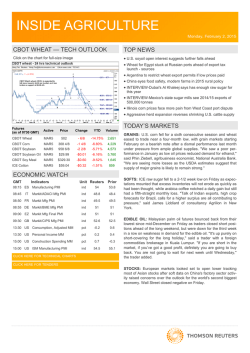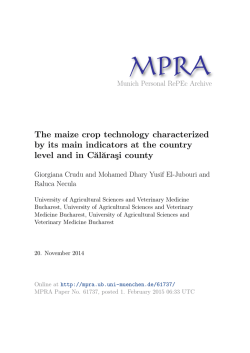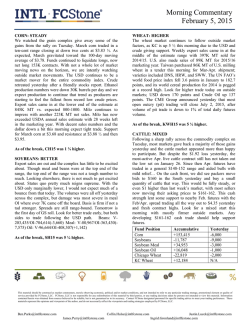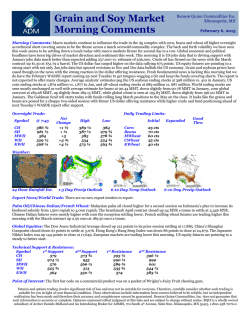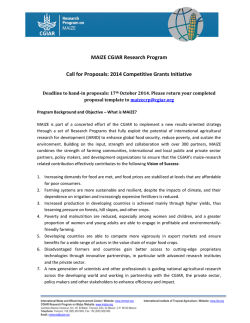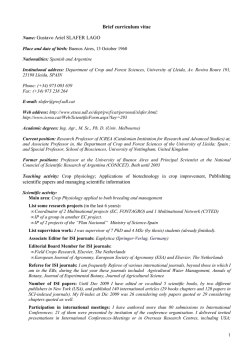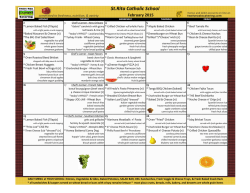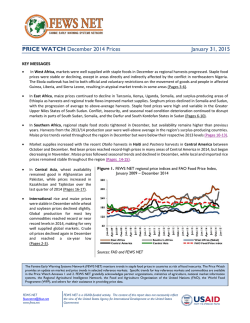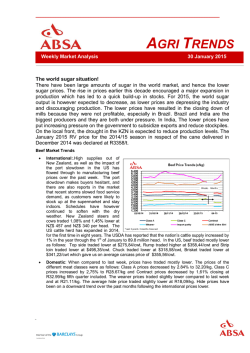
Download (763kB) - Munich Personal RePEc Archive
M PRA Munich Personal RePEc Archive Cereal market in Romania-regional competitiveness Dan Marius Voicilas Romanian Academy-Institute of Agricultural Economics 20. November 2014 Online at http://mpra.ub.uni-muenchen.de/61730/ MPRA Paper No. 61730, posted 1. February 2015 06:23 UTC CEREAL MARKET IN ROMANIA-REGIONAL COMPETITIVENESS DAN-MARIUS VOICILAS1 Abstract: The article analyses the Romanian cereal sector in the last decades. The analysis gives a special attention to the sector development level and its evolution by regions. We analyze areas, productions, yields and the trade with cereals, at national and regional level. We try to identify how competitive the sector is and the main factors of influence, based on some quantitative indicators. Moreover, we identify the negative factors which influenced it. The statistical analysis is based on long data series and concentrates on the years before and after Romania’s accession into EU. We use data provided by the National Institute of Statistics. The results presented show the evolution of the cereal sector after 1989, its decline for about ten years, but also the recovery, especially after the EU accession. The article opens new discussions about the role of the cereal sector in the Romanian economy and the ways of development in the context of a high level of competitiveness among European Union countries and other countries in the world. At the same time, by the present analysis we want to show how the regional performances can contribute to the development of the cereal market in Romania. Key words: cereals, regions, competitiveness, Romania INTRODUCTION In the „90s, the first decade of major structural changes in Romania, the transition influenced the agricultural structures, as well. As a consequence, agriculture experienced important transformations, if we analyze the structure of the Romanian agriculture (crop or animal production), cultivated area, productions or yields. Structural changes are important for our analysis, because they influence the contractual relations between operators on the agri-food chain, policies and strategies at micro or national level, with direct impact on trade, competitiveness and efficiency. The cereal sector was also affected, and this is the reason why we chose to study it, both at national and regional level. The national territory is split into eight economic regions (NUTS2). They are not territorial administrative structures but rather informal organizational structures made up of an average of 4-6 counties (NUTS III) each, except for the regions Sud-Muntenia and Bucureşti-Ilfov. There are many other differences between them, especially from the agricultural point of view. Each region has its own characteristics, from specific relief and natural conditions to economic culture and traditions. The agriculture in general, and the crop production in special, has particularities determined by them. As a result, we meet specific features on the cereal market as well. MATERIALS AND METHODS For the analysis we use data provided by the National Institute of Statistics (INS) and the Ministry of Agriculture and Rural Development (MADR). The statistical analysis is based on long data series (1990-2012) and focuses on the years before and after Romania‟s accession to the European Union (EU), in 2007. For our calculations and comparisons, we selected only a few years during the mentioned period, years with historical significance. This is the reason why the results of the analysis take into account only the following years: 1990, 1991, 1992, 1996, 2000, 2002, 2005, 2007, 2010 and 2012. We have in view all these years either because they were years with agricultural census, structural surveys, or years related to some important political moments, like the years after the “Revolution”, electoral years, or others. The political life had a direct influence on the economic life, as regards the macroeconomic evolution of Romania, but also the regional or sectoral evolution on the way towards EU integration. For example, 2000 represents the year when Romania effectively started the negotiation 1 Senior researcher Ph.D Romanian Academy-Institute of Agricultural Economics, Assoc.prof. Hyperion University, [email protected] process with the EU, in 2005 Romania signed the Accession Treaty and in 2007 Romania joined the EU. RESULTS AND DISCUSSIONS Cereal market The structure of the Romanian crops or crop production is dominated by cereal production. The agricultural areas under these crops represent more than 50% of the cultivated area each year. Out of these, wheat and maize - traditional crops for Romanian agriculture, regardless of household size or farms - have significant percentages. For our calculations, among all varieties of cereals, we selected for deeper analysis only four cereals, considered the main cereals in Romania: wheat, maize, barley and oats. The areas cultivated with cereals declined in the last two decades but, per total, not significantly. The greatest difference in our analysis was recorded in the year 1991 compared with 2010 (Figure 1). Generally, the evolution oscillated, due to the lack of a clear and stable governmental policy in the field. Figure 1. Total areas with selected cereals (thou.ha) Source: Based on INS data (Tempo On-line) The main cereals in Romania represent together over 95% of the Romanian cereal market. Besides wheat and maize, we will next analyze other two cereals like barley and oats. Thus, the cultivated area with the four mentioned cereals is represented in Figure 2. Figure 2. Areas with main cereals Source: Based on INS data (Tempo On-line) The area with maize together with wheat cumulates about 80-85% of the total area cultivated with these cereals, out of which maize has the largest share, i.e. 50-60%. The biggest changes can be noticed in the case of maize, with a descending trend after 2000, compared to the „90s. The other two cereals have a minor role on the cereal market (less than 20%). The area with barley was down in the last years compared to the „90s. Traditionally, Romania is a maize and wheat producer. As regards productions, the analysis shows a few particularities. The total production has had a variable evolution (Figure 3), very close connected to weather conditions. Unfortunately, the production of cereals still depends on temperature, sun exposure and precipitations. There were years with good productions (of course, not compared with the main producers in the world), but also years with weak productions. The oscillation was quite big, if we have in view the comparisons of the year with the best production and that with the weakest production (in 2011 the production was 2.6 times bigger than in 2007). Presently (2012), the production is situated at an average level of the last two decades. Figure 3. Total production of selected cereals (tons) Source: Based on INS data (Tempo On-line) The analysis by types of cereals (Figure 4) shows that maize production is the most important. It is followed by wheat. Generally, 40-50% of the total production of the group of investigated cereals is represented by maize. In the present analysis, the biggest volume was recorded in 1996. At the same time, the barley production decreased in the last years, compared to that in the ‟90s. Figure 4. Production of main cereals Source: Based on INS data (Tempo On-line) At the same time, the yields in the selected years show the weather dependency and the lack of irrigations (Figure 5). The weather dependency mainly includes precipitations (floods or drought) and temperatures (high or extremely low from year to year). Besides all these natural factors of influence, we must have in view the human factors which can affect the level of the economic results as well (irrigations, chemicals, pollution, technologies etc). Figure 5. Yields of main cereals (tons/ha) Source: Based on INS data (Tempo On-line) The best years in the investigated period were those with good weather conditions, balanced as regards precipitations and temperature. On the average, the cereal yields were 2.5-3 tons/ha, with a minimum of 1.5 tons/ha and a maximum of 4 tons/ha. The biggest oscillation was noticed in maize, which is very dependent on precipitations and irrigations (between 1.5-4.5 tons/ha). Only oats was less affected by climate and it had almost a linear evolution. Before 2000, the yields in all cases diminished, and then they slowly increased, except for the year 2007, which was the worst year due to different negative factors, including the weather influence. We can conclude that Romania does not have an intensive agriculture based on modern technologies. Regional competitiveness In order to analyze the regional competitiveness of the cereal sector, we will have in view the statistical comparisons of the Romanian regions, as regards areas, productions and yields. All these indicators, together with different trade indicators, give us information on the level of competitiveness. In the present study we focus on areas, productions and yields. For the beginning, in Figure 6, we analyze the areas cultivated with cereals by regions. Figure 6. Areas with cereals per regions (thou.ha) Source: Based on INS data (Tempo On-line) Among the Romanian regions, Sud-Muntenia is the most important in terms of area cultivated with cereals. It is followed by Sud-Est and Sud-Vest Oltenia regions. All together cumulate over 55% of the Romanian area for cereals and among them Sud-Muntenia has at least 20%. In conclusion, the principal cereal regions for Romania are those situated in the South. In the next two figures, we will analyze the areas with the main cereals (wheat and maize), by regions. Figure 7. Wheat areas by regions Source: Based on INS data (Tempo On-line) In Figure 7 we show the areas under wheat, by regions and their evolution in the last decades. Like in the case of total cereals, the main regions for wheat are: Sud-Muntenia, Sud-Est and Sud-Vest Oltenia. They represent more than 50% of the area cultivated with wheat at national level. The area under this crop increased after 2000 compared to the „90s. Thus, from about 53% in 1990, the areas were extended to about 70% in 2012. Sud-Est Region had about 20%, Sud-Vest Oltenia about 15% but, on the first place is the Region Sud-Muntenia. It contributes with about 32% (2012) compared to 20% in 1990. The most important areas under wheat are found in the southern part of Romania, like in the case of total cereals. Figure 8. Maize areas by regions Source: Based on INS data (Tempo On-line) Maize areas (Figure 8) show us a different situation. The areas covered by maize show that the situation is much more balanced. Still, Sud-Muntenia Region remains the most important with about 20% of total area under maize at national level but, the differences of the rest of the regions are not so evident, like in the case of wheat. Thus, Sud-Est Region and Nord-Est Region have 1819% each, from total area. Sud-Vest Oltenia comes next with about 15%. All together, they have 70-75% of the national area under maize. We see a decreasing trend in Sud-Muntenia Region and an increasing trend in Nord-Est Region. The South of Romania is important for maize, if we have in view the cultivated areas, like in the case of wheat or total cereals. In the next three figures we will present the cereal productions on comparative basis, by regions. Figure 9. Cereal production by regions Source: Based on INS data (Tempo On-line) The total cereal production (Figure 9) shows which the main producers of Romania are. Thus, Sud-Muntenia Region (about 25% of total) is on the first place, followed by Sud-Est Region. Both cumulate about 45% of the national production. The rest of the regions, except for BucurestiIlfov and Centru have a secondary contribution with 10-15% each, of the national production. The biggest variation from year to year is found in Sud-Vest Oltenia Region, due to weather conditions and lack of modern irrigation systems. Figure 10. Wheat production by regions Source: Based on INS data (Tempo On-line) In Figure 10 we present the wheat production, by regions. Sud-Muntenia Region is the main Romanian producer, followed by Sud-Est Region. Together they account for 40-55% of the national production. Sud-Muntenia Region has about 25% of total but, in certain years, it had even over 30% (like in 2011, 2012). We can notice a great production variation due to the weather conditions and even to the national policy in the field. The regions Nord-Vest, Centru, Nord-Est and Bucuresti-Ilfov are less important for wheat production. Figure 11. Maize production by regions Source: Based on INS data (Tempo On-line) Figure 11 presents the situation of maize production, by regions. Like in the case of wheat, the main Romanian producer of maize is Sud-Muntenia Region. It produces about 20-25% of the national production, but the variations from year to year are quite big (about 27% in 1990, 13% in 2000 and 23% in 2012). In the maize case the situation is more balanced of we compare the regions. There is a group of regions with similar contribution to the national production: Sud-Est, Nord-Est, Vest and Sud-Vest (10-20%), also with yearly variations. The remaining regions do not have important contributions. In the next figures (Figure 12, 13, 14), we want to analyze the yields by regions, for total cereals, wheat and maize. Figure 12. Cereal yields by regions (kg/ha) Source: Based on INS data (Tempo On-line) For total cereals, the yields show a few particularities at regional level (Figure 12). Firstly, they are closely connected to weather conditions, the precipitations being the most important factor of influence. In those areas where irrigation systems are used, the yields are not affected. At the same time, there are regions without irrigation systems but with a good level of annual rainfall. They can also have good level of yields. Small variations from year to year are found in the regions Vest, Nord-Vest and Centru. The rest of the regions are directly influenced by rainfall (mainly SudVest Oltenia, Sud-Muntenia, Sud-Est and Nord-Est). Secondly, there is a region that improved its performances. It is the Region Vest, which presently produce on the average more than in the „90s, with yields between 3000-4000 kg/ha in recent years, after Romania‟s accession to the EU. The remaining regions produce on the average at the same level like in the „90s or even less (Sud-Vest Oltenia, Bucuresti-Ilfov). Generally, the yields had a constant descending trend before 2000, and then great annual variations appeared, with historical maximum and minimum. Figure 13. Wheat yields by regions (kg/ha) Source: Based on INS data (Tempo On-line) If we analyze the cereal group by sub-groups, we identify a few differences. In the last years, the wheat yields have almost the same level with those from the beginning of the „90s (Figure 13). After many years of decline and yearly variations, after the accession, the yields look much more stabilized. Again, we underline the plus for Vest Region, with higher yields, which also had small variations during the analyzed period. Figure 14. Maize yields by regions (kg/ha) Source: Based on INS data (Tempo On-line) The situation is not the same for maize, which continues to have yearly variations (Figure 14), in all regions, especially in Sud-Vest Oltenia. Presently, the yields are smaller in all regions than at the beginning of the „90s. Trade In the next part of the paper, we want to analyze the Romanian trade with cereals, in intraEU and extra-EU zone. For this, we calculated the share of the main Romanian cereals in total Romanian agri-food exports, and the share of the Romanian agri-food products in the EU intratrade. We also compare the trade with cereals with the trade with other Romanian agri-food products. In this way, we want to identify which are the “winners” of the last decades, among the Romanian agri-food products and especially among cereal products. If we have in view the main Romanian cereals exported during the period analyzed, the “winners” of the last decades, which are products still competitive, are presented in Table 1. Table 1. Share of products in total Romanian agri-food export (FOB) – “Winners” Years 1991 1995 2000 2004 2007 2010 Sheep (+ Goats) 9.8 11.2 14.8 20 11.6 4.7 Honey 0.6 0.8 3.2 4.4 1.8 1.7 Wheat 5.7 27.3 4.9 0.9 7.1 19.9 Barley 0.03 0.2 3.4 1.2 4.1 5 Maize 0.2 7.4 5.1 8.5 11.6 20.9 Rape seeds 0.04 0.03 5.2 1.9 12.1 17.1 Sunflower seeds 0.04 0.8 7.1 15.4 16.1 11.5 Sunflower oil 2.4 16.5 5.2 11.4 5.4 6 Source: Voicilas, 2013 We can say that wheat and maize from the cereal group are important for the Romanian agri-food trade and (still) competitive in the world (including EU market), while barley is less important. Next in this subchapter, we want to know the share of the Romanian agri-food products in the EU intra-trade market, in FOB prices. Which are the most competitive Romanian agri-food products on the intra-EU market? This is another estimation of the competitiveness of the Romanian agri-food products at EU level (Table 2). Table 2. Share of Romanian agri-food exports in EU intra-trade market (FOB) Products 2004 2007 2008 2009 2010 2011 Cereals 0.3 1.0 1.2 3.7 4.2 3.8 Oilseeds 1.6 1.7 5.8 5.5 6.6 7.2 Honey 7.4 5.3 5.8 10.1 9.4 8.4 Sheep 31.8 26.5 32.4 33.7 32.0 36.5 Wheat 0.07 0.8 1.3 3.9 3.7 3.4 Maize 1.2 5.5 7.3 6.7 1.8 1.9 Source: Voicilas, 2013 Having in view the data presented, we identify two types of products: active (honey, sheep) and passive (cereals, oilseeds). Among cereals, wheat and maize stand out. The active products have an ascending trend and very good perspectives (competitiveness) and the passive products have a linear evolution under the pressure of different factors. CONCLUSIONS At the end, we would like to summarize our analysis in a few comprehensive words: undeveloped, disparities, not competitive. In details, we can add that the cereal sector in Romania is still less developed; the majority of the regions are almost at the same level of production like at the beginning of the „90s (compared to similar sectors in other EU countries, the differences could be bigger). Only the Region Vest improved its performances, with higher yields in recent years. In the remaining regions, the sector is still developing and under the direct influences of the natural (weather) conditions. In terms of quality of work (productivity), the Region Vest appears as the most important. If we analyze the quantities, Sud-Muntenia, Sud-Est and Sud-Vest Oltenia are the most important, having in view the size of the areas cultivated with cereals and the total production of cereals. We can imagine that, if the same technologies were applied in all these regions as those applied in the Region Vest, the results could be much better. At the same time, the differences between regions are also the result of the weather conditions, soil quality or level of utilization of the modern technologies, including irrigation systems. We can conclude that the cereal sector is not competitive (as a whole), but there are products or regions with good level of performances, similar to those in other competitive EU countries. For example, among cereals only wheat and maize could be considered competitive, even if in intra-EU trade these have passive role. At the same time, the cereal sector remains one of the most competitive sectors of the Romanian economy, with huge volumes and values in intra- and extra-EU trade. Among regions, we highlight Sud-Muntenia, Sud-Est, Sud-Vest and Vest, which have potential, good performances in some years and can improve their competitiveness at EU and world level. Moreover, we can add that the lack of the stable and rigorous legislation and the weaknesses of the national institutions determined the present state of the Romanian cereal market, which cannot compete with other markets in EU or other regions in Europe. ACKNOWLEDGEMENTS Work under: FP 7 COMPETE Project “International comparisons of product supply chains in the agro-food sectors: determinants of their competitiveness and performance on EU and international markets”, Grant Agreement No. 312029 (http://compete-project.eu/), with funding from the European Community and the Ministry of National Education from Romania through the Executive Unit for Funding Higher Education, Research, Development and Innovation, project coordinated by IAMO (Halle/Saale-Germany), partner Institute of Agricultural Economics-Romanian Academy (Team leader: D.M.Voicilas) BIBLIOGRAPHY 1. 2. Voicilaş, D.M. (2013). Gains and losses of Romanian agri-food products on EU intra-trade market, in Popescu, G., Istudor, N., Boboc, D. (editors), Proceedings of the 2-nd International Conference “Competitiveness of agro-food and environmental economy” (CAFEE‟13), Bucharest, pp. 401-409. (http://www.cafee.ase.ro/?page_id=202) [2014 04 28]. ***, INS Database (tempo on-line, www.insse.ro)
© Copyright 2026
